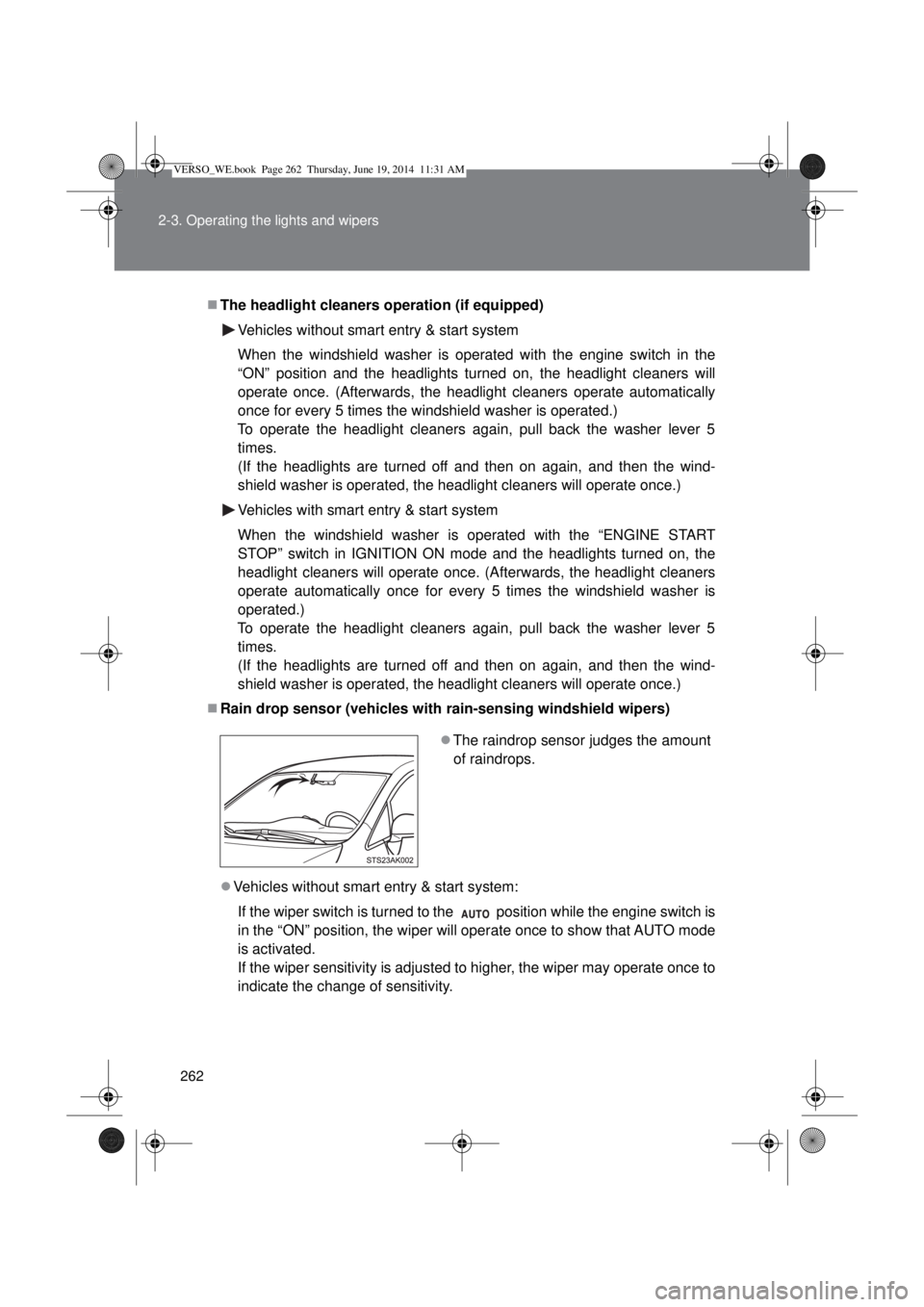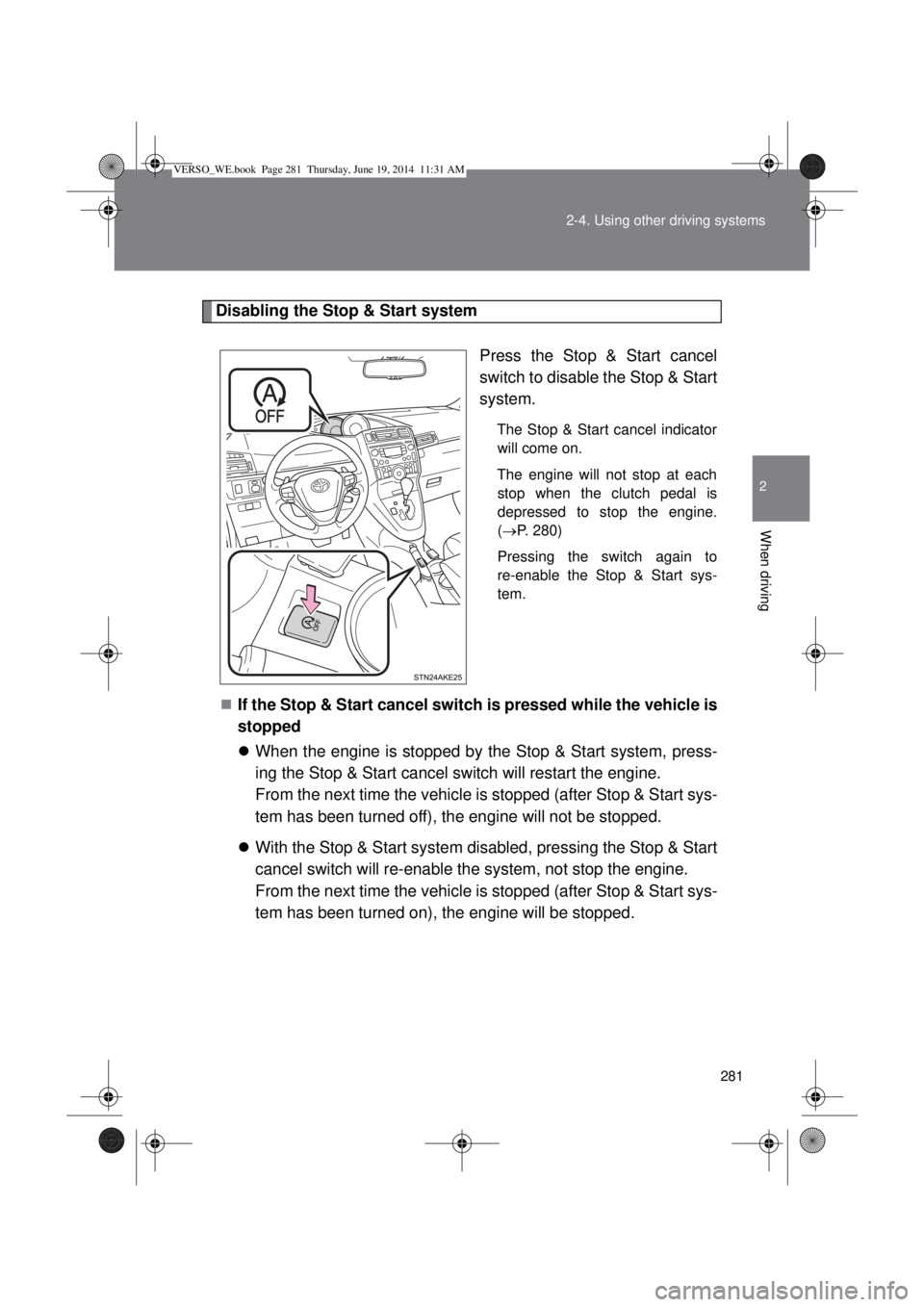Page 261 of 650
261 2-3. Operating the lights and wipers
2
When driving
The windshield wipers and washer can be operated when
Vehicles without smart entry & start system
The engine switch is in the “ON” position.
Vehicles with smart entry & start system
The “ENGINE START STOP” switch is in IGNITION ON mode.
Sensor sensitivity (high)
Sensor sensitivity (low)
Wash/wipe operation
Wipers operate automati-
cally.
Vehicles with headlight clean-
ers: P. 262
VERSO_WE.book Page 261 Thursday, June 19, 2014 11:31 AM
Page 262 of 650

262 2-3. Operating the lights and wipers
The headlight cleaners operation (if equipped)
Vehicles without smart entry & start system
When the windshield washer is operated with the engine switch in the
“ON” position and the headlights turned on, the headlight cleaners will
operate once. (Afterwards, the headlight cleaners operate automatically
once for every 5 times the windshield washer is operated.)
To operate the headlight cleaners again, pull back the washer lever 5
times.
(If the headlights are turned off and then on again, and then the wind-
shield washer is operated, the headlight cleaners will operate once.)
Vehicles with smart entry & start system
When the windshield washer is operated with the “ENGINE START
STOP” switch in IGNITION ON mode and the headlights turned on, the
headlight cleaners will operate once. (Afterwards, the headlight cleaners
operate automatically once for every 5 times the windshield washer is
operated.)
To operate the headlight cleaners again, pull back the washer lever 5
times.
(If the headlights are turned off and then on again, and then the wind-
shield washer is operated, the headlight cleaners will operate once.)
Rain drop sensor (vehicles with rain-sensing windshield wipers)
Vehicles without smart entry & start system:
If the wiper switch is turned to the position while the engine switch is
in the “ON” position, the wiper will operate once to show that AUTO mode
is activated.
If the wiper sensitivity is adjusted to higher, the wiper may operate once to
indicate the change of sensitivity.
The raindrop sensor judges the amount
of raindrops.
VERSO_WE.book Page 262 Thursday, June 19, 2014 11:31 AM
Page 263 of 650

263 2-3. Operating the lights and wipers
2
When driving
Vehicles with smart entry & start system:
If the wiper switch is turned to the position while the “ENGINE
START STOP” switch is in IGNITION ON mode, the wiper will operate
once to show that AUTO mode is activated.
If the wiper sensitivity is adjusted to higher, the wiper may operate once to
indicate the change of sensitivity.
If the temperature of the raindrop sensor is 85°C (185°F) or higher, or
-40°C (-40°F) or lower, automatic operation may not occur. In this case,
operate the wipers in any mode other than AUTO.
If no windshield washer fluid sprays
Check that the washer nozzles are not blocked and if there is washer fluid in
the windshield washer fluid reservoir.
CAUTION
Caution regarding the use of windshield wipers in AUTO mode
The windshield wipers may operate unexpectedly if the sensor is touched or
the windshield is subject to vibration in AUTO mode. Take care that your fin-
gers or anything else do not become caught in the windshield wipers.
Caution regarding the use of washer fluid
When it is cold, do not use the washer fluid until the windshield becomes
warm. The fluid may freeze on the windshield and cause low visibility. This
may lead to an accident, resulting in death or serious injury.
NOTICE
When the windshield is dry
Do not use the wipers, as they may damage the windshield.
When the washer fluid tank is empty
Do not use the washer when the washer fluid tank is empty. This may cause
the washer fluid pump to overheat.
When there is no windshield washer fluid spray from the nozzle
Damage to the washer fluid pump may be caused if the lever is pulled
toward you and held continually.
VERSO_WE.book Page 263 Thursday, June 19, 2014 11:31 AM
Page 264 of 650
264
2-3. Operating the lights and wipers
Rear window wiper and washer
The rear window wiper and washer can be operated when
Vehicles without smart entry & start system
The engine switch is in the “ON” position.
Vehicles with smart entry & start system
The “ENGINE START STOP” switch is in IGNITION ON mode.
NOTICE
When the rear window is dry
Do not use the wipers, as they may damage the rear window.
When the washer fluid tank is empty
Do not use the washer when the washer fluid tank is empty. This may cause
the washer fluid pump to overheat.
Intermittent window
wiper operation
Normal window wiper
operation
Washer/wiper dual
operation
Washer/wiper dual
operation
VERSO_WE.book Page 264 Thursday, June 19, 2014 11:31 AM
Page 276 of 650

276 2-4. Using other driving systems
Detection range of the sensors
Approximately 100 cm (3.2 ft.)
Approximately 150 cm (4.9 ft.)
Approximately 60 cm (2.0 ft.)
The diagram shows the detection
range of the sensors. Note that
the sensors cannot detect obsta-
cles that are extremely close to
the vehicle.
The range of the sensors may
change depending on the shape
of the object etc.
The Toyota parking assist-sensor can be operated when
The Toyota parking assist-sensor switch is on.
Vehicles without smart entry & start system:
The engine switch is in “ON” position.
Vehicles with smart entry & start system:
The “ENGINE START STOP” switch is in IGNITION ON mode.
Front center sensors:
• The shift lever is in a position other than “P” (Multidrive or automatic
transmission) or “R”.
• The vehicle speed is less than about 10 km/h (6 mph).
Front corner sensors:
• The shift lever is in a position other than “P” (Multidrive or automatic
transmission).
• The vehicle speed is less than about 10 km/h (6 mph).
VERSO_WE.book Page 276 Thursday, June 19, 2014 11:31 AM
Page 280 of 650
280
2-4. Using other driving systems
Stop & Start system
: If equipped
The Stop & Start system stops and restarts the engine according to
the clutch pedal operation for stopping and starting the vehicle.
Stopping the engine
With the clutch pedal fully depressed, stop the vehicle.
Then shift the shift lever to “N”.
Release the clutch pedal.
The engine will stop and Stop
& Start indicator will come on.
Restarting the engine
Check that the shift lever is in “N” and depress the clutch pedal.
The engine will restart. The Stop & Start indicator will go off.
(In this situation, releasing the clutch pedal will not stop the engine
again.)
VERSO_WE.book Page 280 Thursday, June 19, 2014 11:31 AM
Page 281 of 650

281 2-4. Using other driving systems
2
When driving
Disabling the Stop & Start system
Press the Stop & Start cancel
switch to disable the Stop & Start
system.
The Stop & Start cancel indicator
will come on.
The engine will not stop at each
stop when the clutch pedal is
depressed to stop the engine.
(P. 280)
Pressing the switch again to
re-enable the Stop & Start sys-
tem.
If the Stop & Start cancel switch is pressed while the vehicle is
stopped
When the engine is stopped by the Stop & Start system, press-
ing the Stop & Start cancel switch will restart the engine.
From the next time the vehicle is stopped (after Stop & Start sys-
tem has been turned off), the engine will not be stopped.
With the Stop & Start system disabled, pressing the Stop & Start
cancel switch will re-enable the system, not stop the engine.
From the next time the vehicle is stopped (after Stop & Start sys-
tem has been turned on), the engine will be stopped.
VERSO_WE.book Page 281 Thursday, June 19, 2014 11:31 AM
Page 282 of 650

282 2-4. Using other driving systems
Operating conditions
The Stop & Start system is operational when all of the following condi-
tions are met:
• The engine is adequately warmed up.
• The battery is sufficiently charged.
• The driver’s door is closed.
• The driver’s seat belt is fastened.
• The hood is closed.
• The clutch pedal is not being depressed.
• The shift lever is in “N”.
• The steering wheel is not in use.
In the following circumstances the engine may not be stopped by the
Stop & Start system. This is not a malfunction of the Stop & Start system.
• Engine coolant temperature is too low or too high.
• The outside temperature is too low.
• Vehicles with an automatic air conditioning system: The air condition-
ing system is being used when the vehicle interior temperature is
extremely high such as after the vehicle was parked under the hot sun.
• Vehicles with an automatic air conditioning system: The windshield
defogger is being used.
• Vehicles with a power heater: The power heater is being used.
• The battery is not sufficiently charged, or is undergoing a periodic
recharge.
• Due to traffic or other circumstances the vehicle is stopped repeatedly,
resulting in the amount of time the engine is stopped by the Stop &
Start system to become excessively high.
• The brake booster vacuum is low.
• A large amount of electricity is being used.
• At high altitude.
When the above conditions improve, the Stop & Start system will stop and
restart the engine from the next time the vehicle is stopped.
In the following situations, it may take longer than normal for the Stop &
Start system to activate.
• The battery is discharged.
• After the battery terminals have been disconnected and reconnected
after a battery replacement, etc.
• The engine coolant temperature is low.
VERSO_WE.book Page 282 Thursday, June 19, 2014 11:31 AM